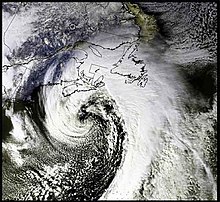Nor'easter
A nor'easter (also northeaster) is a big storm along the East Coast of the United States. A Nor'easter is called that because the winds in a Nor'easter come from the northeast, especially in the coastal areas of the Northeastern United States and Atlantic Canada. More specifically, it is a low pressure area whose center of rotation is just off the East Coast and whose leading winds in the left forward quadrant rotate onto land from the northeast. The precipitation pattern is similar to other extratropical storms. Nor'easters also can cause coastal flooding, coastal erosion, hurricane force winds, and heavy snow. Nor'easters are associated with warm fronts, cold fronts, or occluded fronts. Nor'easters can occur at any time of the year but are mostly known for their presence in the winter.[1] Nor'easters can be devastating and damaging, especially in the winter months, when most damage and deaths are from the cold. Nor'easters bring very cold air down from the Arctic. Nor'easters thrive on the converging air masses; that is, the polar cold air mass and the warmer ocean water of the Gulf Stream.[1] Nor'easters will usually develop between 30° N. and 35° N.
References[change | change source]


